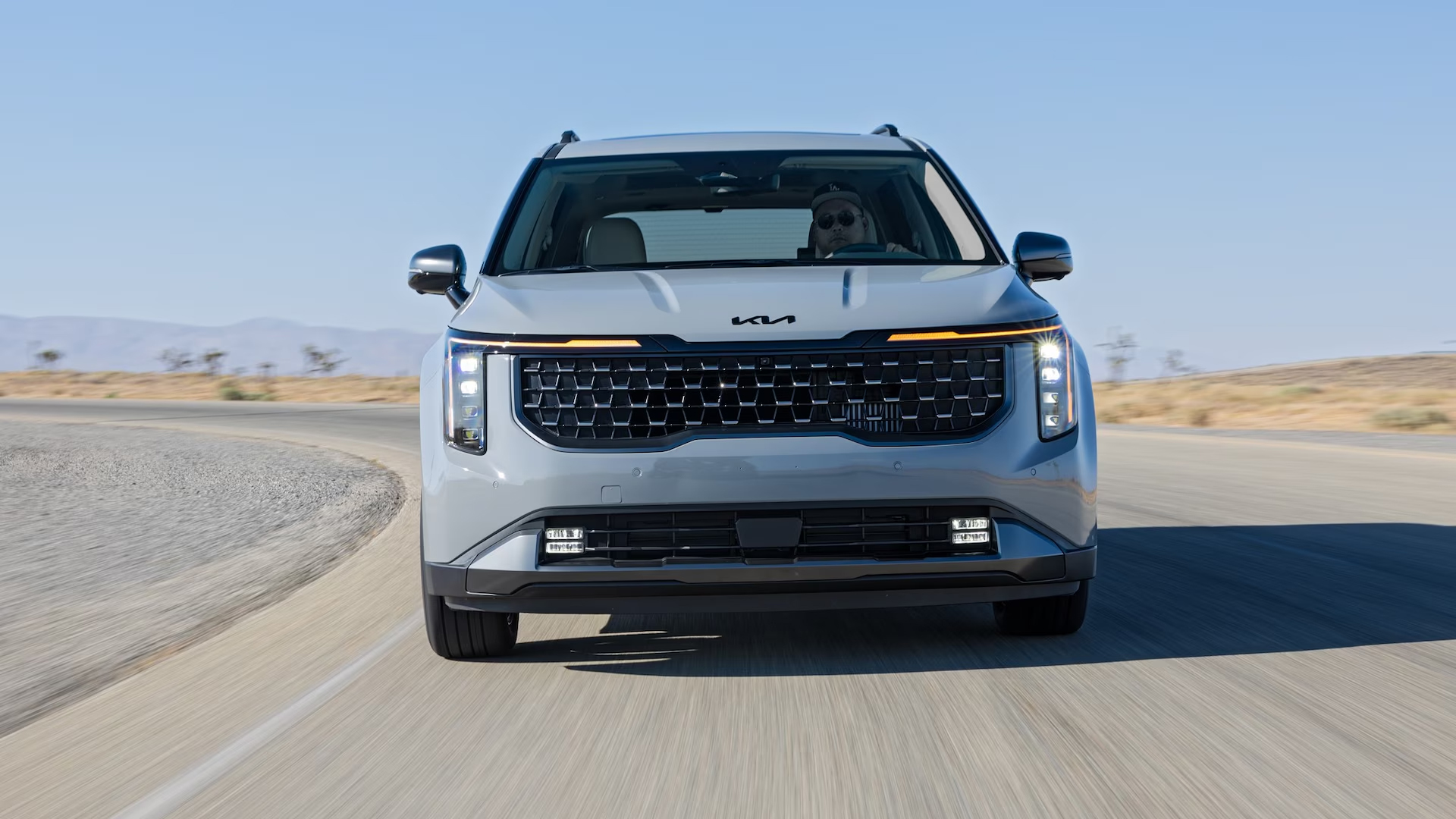Kia’s 2025 Carnival minivan now comes with a hybrid powertrain option as part of a mid-cycle update, aiming to blend the practicality of a family vehicle with the fuel efficiency of a hybrid. While Kia continues to avoid the “minivan” label, emphasizing a more SUV-like design, this update makes the Carnival more visually appealing with a front-end design borrowed from the Kia EV9 and Sorento SUVs. But does the addition of hybrid power make the Carnival a better choice, or does it fall short compared to its non-hybrid sibling?
Interior Comfort and Features
Our test model, priced at $56,990, featured an upscale interior with a navy and white theme, complete with white perforated leather seats, blue trim, and sleek chrome accents. The cabin includes a large, curved touchscreen display and a well-thought-out layout for charging options, including power outlets and USB ports. The integration of Apple CarPlay was simple, though navigating back to the home screen once CarPlay was engaged proved difficult. Kia also redesigned the center console for the hybrid model, replacing the traditional gear lever with a dial and adding buttons for various features like heated seats and a camera system.
The seating in the second row posed some challenges. While the Carnival offers a lot of passenger space, the high floor and low roof made entry and exit somewhat awkward. The second-row seats are especially heavy and hard to move, with levers and controls that are poorly marked and difficult to use. Access to the third row was tight for adults, but fine for children, though the narrow window line made the rear feel a bit cramped. The removable middle seat in the second row is also cumbersome to reinstall, requiring a precise alignment of the seat rails and some patience.
For second-row passengers, there are plenty of amenities, including a large fold-down console, power outlets, USB ports on the sides of the front seats, and rear climate controls. While these features look great on paper, their functionality didn’t always live up to expectations.
Driving Impressions: Is the Hybrid Worth It?
Kia’s goal with the hybrid Carnival is clear: deliver a family-oriented vehicle that drives like an SUV, and for the most part, it succeeds. However, the hybrid’s added weight, compared to the regular model, impacts its agility. While the hybrid delivers adequate power, especially on highways, it sometimes feels sluggish when you need a burst of speed or when climbing hills. The engine can also get buzzy under heavy acceleration, and the performance lags behind the non-hybrid version in some objective tests.
With a combined output of 242 horsepower and 271 lb-ft of torque, the hybrid feels strong enough for most driving situations, but it lags behind the V-6-powered Carnival in acceleration, taking 7.9 seconds to reach 60 mph compared to the non-hybrid’s 7.5 seconds. The hybrid’s brakes, while offering good progressive feel and a shorter stopping distance (118 feet from 60 mph versus 132 feet in the regular model), can feel a bit too sensitive at times.
Handling is another area where the hybrid feels like an SUV, with slightly heavy steering and noticeable body roll in tight turns or on rough surfaces. However, the electric steering system does offer good feedback and precision, making it one of the more enjoyable aspects of driving the hybrid. The adaptive cruise control and lane-keeping assist features are also standouts in terms of both convenience and safety.
Fuel Economy: The Hybrid Advantage?
In terms of fuel efficiency, the Carnival Hybrid shows some improvement over its non-hybrid sibling, achieving 34 mpg city, 31 mpg highway, and 33 mpg combined. While these numbers are respectable, they don’t make it a clear winner over competitors. For instance, the Toyota Sienna Hybrid offers better efficiency at 36 mpg across the board. The Chrysler Pacifica Hybrid, a plug-in hybrid, blows both away with an impressive 82 mpg-e and the ability to drive up to 32 miles on electric power alone.
For those who primarily drive in the city, the Carnival Hybrid offers a significant advantage over the regular model, which struggles with fuel economy at just 18 mpg in urban settings. However, on the highway, the gap narrows considerably, as the regular V-6-powered Carnival achieves 26 mpg. In real-world testing, the hybrid’s fuel economy didn’t drastically outshine that of the non-hybrid version, and the hybrid’s several-thousand-dollar price premium may not justify the modest fuel savings for some buyers.
Final Thoughts: Does the Hybrid Shine?
While hybrids often offer better efficiency and performance, the 2025 Kia Carnival Hybrid doesn’t necessarily outshine its non-hybrid counterpart. The regular Carnival, with its 3.5-liter V-6, offers more responsive acceleration, lighter handling, and smoother braking performance. For those prioritizing power and driving dynamics, the V-6-powered version may be the more enjoyable choice.
Yes, the hybrid offers better fuel efficiency—particularly in the city—but its performance is not enough to justify the extra cost for many shoppers. If fuel economy is a top priority, buyers might find better options in the Toyota Sienna Hybrid or the Chrysler Pacifica Hybrid. For those who don’t mind a slightly less efficient but more fun-to-drive experience, the regular Carnival may still be the better bet.
Key Takeaways:
- Performance: The Carnival Hybrid offers adequate power but lags behind the V-6 in acceleration and driving feel.
- Interior: Stylish but with some functionality issues, especially in the second-row seating.
- Fuel Economy: The hybrid offers better city efficiency but doesn’t outperform competitors or justify the price premium.
- Competitors: The Toyota Sienna Hybrid and Chrysler Pacifica Hybrid offer more impressive efficiency and electric-only driving range.
Ultimately, the 2025 Kia Carnival Hybrid is a solid option for families, but whether it’s the best choice depends on how much weight you place on fuel savings versus performance and driving enjoyment.
